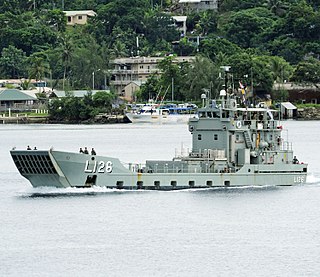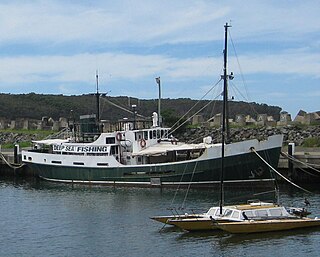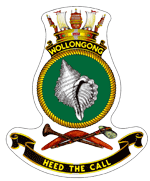
HMAS Betano was a Balikpapan-class heavy landing craft operated by the Royal Australian Navy (RAN).

The Balikpapan class is a ship class of eight heavy landing craft. All eight were originally laid down by Walkers Limited for the Australian Army in the early 1970s. A reorganisation of watercraft responsibilities in the Australian military meant the landing craft were to be operated by the Royal Australian Navy (RAN), with seven commissioned directly into RAN service during 1973 and 1974, and lead ship Balikpapan transferred from the army to the navy. During the leadup to the independence of Papua New Guinea in 1975, two of the vessels were transferred to the new Papua New Guinea Defence Force (PNGDF).

HMAS Armidale, named for the city of Armidale, New South Wales, is the lead ship of the Armidale class of patrol boats serving in the Royal Australian Navy (RAN). It was commissioned in June 2005 and decommissioned in March 2023.

HMAS Sirius was a commercial tanker purchased by the Royal Australian Navy and converted into a fleet replenishment vessel to replace HMAS Westralia. She was named in honour of HMS Sirius of the First Fleet. Launched in South Korea on 2004, and converted in Western Australia, Sirius was commissioned in 2006; three years before a purpose-built vessel would have been built, and at half the cost. The tanker was decommissioned in 2021.

HMAS Larrakia is an Armidale-class patrol boat of the Royal Australian Navy (RAN).

HMAS Albany, named for the city of Albany, Western Australia, is an Armidale-class patrol boat of the Royal Australian Navy (RAN).

HMAS Pirie, named for the city of Port Pirie, South Australia, is an Armidale-class patrol boat of the Royal Australian Navy (RAN).

PBAT Sentinel, formally HMAS Maitland, named for the city of Maitland, New South Wales, is an Armidale-class patrol boat of the Royal Australian Navy (RAN).

HMAS Ararat, named for the town of Ararat, Victoria, was an Armidale-class patrol boat of the Royal Australian Navy (RAN).

HMAS Banks was an Explorer class general-purpose vessel of the Royal Australian Navy (RAN), serving in a range of capacities from 1960 until 1995. She was named in honour of Sir Joseph Banks, the botanist aboard HM Bark Endeavour during the discovery of the eastern coast of Australia in 1770.

HMAS Broome, named for the city of Broome, Western Australia, is an Armidale-class patrol boat of the Royal Australian Navy (RAN).

HMAS Wollongong, named for the city of Wollongong, was an Armidale-class patrol boat of the Royal Australian Navy (RAN).

HMAS Childers is an Armidale-class patrol boat of the Royal Australian Navy (RAN). Named for the towns of Childers, Queensland and Childers, Victoria, Childers is the only ship in the RAN to be named after two towns.

HMAS Maryborough, named after the city of Maryborough, Queensland, is one of fourteen Armidale-class patrol boats operated by the Royal Australian Navy (RAN).
HMAS Glenelg, named for the city of Glenelg, South Australia was an Armidale-class patrol boat of the Royal Australian Navy (RAN).

The Fantome class is a class of eight small survey motor boats (SMBs) operated by the Royal Australian Navy (RAN) and DMS Maritime. The four-man boats are designed to operate from the Leeuwin-class survey vessels, with three assigned to each ship, while the seventh and eighth were attached to the RAN Hydrographic School at HMAS Penguin. They are fitted with navigational and survey equipment and are unarmed.
TRV Trevally (802) was one of three Torpedo Recovery Vessels operated by the Royal Australian Navy (RAN) and Defence Maritime Services (DMS). Ordered in 1969, the vessel, originally identified as TRV 254, was completed in 1970 and assigned to the naval base HMAS Waterhen in Sydney. The ship received a name and the pennant number "TRV 802" in 1983. In 1988, the three vessels were sold to DMS. Trevally remained at Waterhen under DMS control. Trevally was active in DMS service as of 2007.
TRV Tailor (803) was one of three Torpedo Recovery Vessels operated by the Royal Australian Navy (RAN) and Defence Maritime Services (DMS). Ordered in 1969, the vessel, originally identified as TRV 255, was completed in 1971 and assigned to the naval base HMAS Waterhen in Sydney. The ship received a name and the pennant number "TRV 803" in 1983. In 1988, the three vessels were sold to DMS. Tailor was assigned to the naval base HMAS Creswell in Western Australia. Tailor was decommissioned in 2018.
The Fish class was a ship class of three torpedo recovery vessels previously operated by Defence Maritime Services (DMS).

The Craft of Opportunity Program (COOP) was a Royal Australian Navy (RAN) acquisition program intended to supplement the navy's mine warfare capability with civilian vessels that could be quickly converted into minesweepers. Vessels acquired under COOP were not commissioned into the RAN, and instead operated with the prefix "MSA" (Minesweeper Auxiliary).














